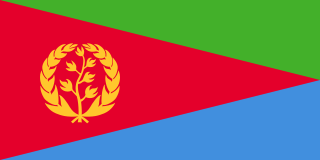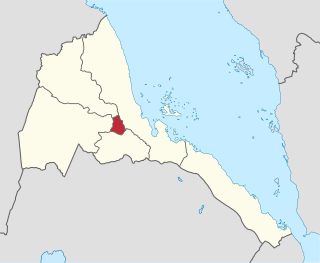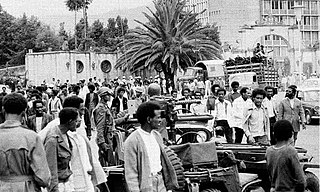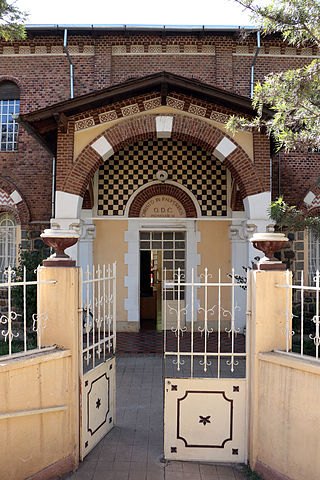Related Research Articles

Eritrea is an ancient name, associated in the past with its Greek form Erythraia, Ἐρυθραία, and its derived Latin form Erythræa. This name relates to that of the Red Sea, then called the Erythræan Sea, from the Greek for "red", ἐρυθρός, erythros. But earlier Eritrea was called Mdre Bahri. The Italians created the colony of Eritrea in the 19th century around Asmara and named it with its current name. After World War II, Eritrea annexed to Ethiopia. Following the communist Ethiopian government's defeat in 1991 by the coalition created by armed groups notably the EPLF, Eritrea declared its independence. Eritrea officially celebrated its 1st anniversary of independence on May 24, 1993.

Haile Selassie I was Emperor of Ethiopia from 1930 to 1974. He rose to power as the Regent Plenipotentiary of Ethiopia under Empress Zewditu between 1916 and 1930. Widely considered to be a defining figure in modern Ethiopian history, he is accorded divine importance in Rastafari, a relatively new Abrahamic religion that emerged in the Colony of Jamaica in the 1930s. A few years before he began his reign over the Ethiopian Empire, Selassie defeated Ethiopian army commander Ras Gugsa Welle Bitul, who was the nephew of Empress Taytu Betul, during the Battle of Anchem. He belonged to the Solomonic dynasty, which was founded by Emperor Yekuno Amlak in 1270; Amlak's successors claimed that he was a lineal descendant of Menelik I, the legendary Emperor of Ethiopia who was supposedly born to King Solomon and Queen Makeda of the Kingdom of Israel and the Kingdom of Sheba, respectively. Modern historians regard the Solomonic lineage claim as an unfounded myth created by Yekuno Amlak to justify wresting power from the Zagwe Dynasty.

Asmara, or Asmera, is the capital and most populous city of Eritrea, in the country's Central Region. It sits at an elevation of 2,325 metres (7,628 ft), making it the sixth highest capital in the world by altitude and the second highest capital in Africa. The city is located at the tip of an escarpment that is both the northwestern edge of the Eritrean Highlands and the Great Rift Valley in neighbouring Ethiopia. In 2017, the city was declared as a UNESCO World Heritage Site for its well-preserved modernist architecture. According to local traditions, the city was founded after four separate villages unified to live together peacefully after long periods of conflict. Asmara had long been overshadowed by nearby Debarwa, the residence of the Bahr Negash or the governor of the coastal province, however it still existed as a major settlement for over half a millennium and enjoyed some importance as it stood on the trade route to Massawa. Asmara first rose to prominence during the 20th century, when it became capital of Italian Eritrea. Under Italian rule the city of Asmara experienced rapid urbanization and modernization.

The Central Region, is an administrative region of Eritrea, located in central Eritrea. The region was formed on 15 April 1996, from the historical province of Hamasien. The region is located on the central plateau, and sits at an average of about 2,250 metres (7,380 ft) above sea level. It contains Asmara, the capital and largest city of Eritrea.

Adigrat is a city and separate woreda in Tigray Region of Ethiopia. It is located in the Misraqawi Zone at longitude and latitude 14°16′N39°27′E, with an elevation of 2,457 metres (8,061 ft) above sea level and below a high ridge to the west. Adigrat is a strategically important gateway to Eritrea and the Red Sea. Adigrat was part of Ganta Afeshum woreda before a separate woreda was created for the city. Currently, Adigrat serves as the capital of the Eastern Tigray zone.

The Eritrean Liberation Front, colloquially known as Jebha, was the main independence movement in Eritrea which sought Eritrea's independence from Ethiopia during the 1960s and the early 1970s.
The Wefri Warsay Yika'alo (WWY) or Warsay Yika'alo Program of Eritrea is an ambitious project of post-war recovery. It is similar to other economic recovery programs and is often compared to the Marshall Plan.1, 2, 3

The Ethiopian Civil War was a civil war in Ethiopia and present-day Eritrea, fought between the Ethiopian military junta known as the Derg and Ethiopian-Eritrean anti-government rebels from 12 September 1974 to 28 May 1991.

The National Museum of Eritrea is a national museum in Asmara, Eritrea. Established in 1992 by Woldeab Woldemariam, it was originally located in the former Governor's Palace until 1997, when it was moved. The venue has since been relocated to the former Comboni Sisters School for Women.
Articles related to Eritrea include:

The Ethiopian Navy, known as the Imperial Ethiopian Navy until 1974, is the naval branch of the Ethiopian National Defense Force founded in 1955. It was disestablished in 1996 after the independence of Eritrea in 1993, which left Ethiopia landlocked. However, the Ethiopian Navy was re-established in 2019 as a brown water navy and is based in Lake Tana in Bahir Dar, Amhara region.
The Commercial Bank of Eritrea is the only banking institution in Eritrea with full retail commercial banking services. It is a government-owned bank, with 17 branches throughout the country. The Bank has arrangements with Citibank for international money transfer, as well as with Deutsche Bank.

The Eritrea Institute of Technology (EIT) or Mai-Nefhi College is a technological institute located near the town Himbrti, Mai Nefhi, Eritrea. It is situated about 12 km southwest of Asmara, near the Mai Nefhi dam. The institute has three colleges: Science, Engineering and Technology, and Education. The institute began with about 5,500 students during the 2003-2004 academic year.

Eritrea, officially the State of Eritrea, is a country in the Horn of Africa region of Eastern Africa, with its capital and largest city being Asmara. It is bordered by Ethiopia in the south, Sudan in the west, and Djibouti in the southeast. The northeastern and eastern parts of Eritrea have an extensive coastline along the Red Sea. The nation has a total area of approximately 117,600 km2 (45,406 sq mi), and includes the Dahlak Archipelago and several of the Hanish Islands.

Italians of Ethiopia are Ethiopian-born citizens who are fully or partially of Italian descent, whose ancestors were Italians who emigrated to Ethiopia starting in the 19th century during the Italian diaspora, or Italian-born people in Ethiopia.

Bereket Mengisteab is an Eritrean songwriter, composer and singer.

Italian Ethiopia, also known as the Italian Empire of Ethiopia, was the territory of the Ethiopian Empire, which Italy occupied for approximately five years. Italian Ethiopia was not an administrative entity, but the formal name of the former territory of the Ethiopian Empire, which now constituted the Governorates of Amhara, Harar, Galla-Sidamo, and Scioa after the establishment of Italian East Africa.

Asmara Theatre, also known as Asmara Opera, is a theatre in Asmara, Eritrea. It was constructed in 1918 following a design by the Italian engineer Odoardo Cavagnari, with later renovations in 1936.

Ethiopia–Yugoslavia relations were historical foreign relations between Ethiopia and now split-up Socialist Federal Republic of Yugoslavia. Both countries were among founding members of the Non-Aligned Movement. The first contacts between the two countries were established at the United Nations in 1947 where Yugoslavia supported Ethiopian claims on Eritrea while Ethiopia supported Yugoslav claims over the Free Territory of Trieste. After the 1948, Tito-Stalin split Yugoslavia turned towards the non-bloc countries and two countries opened their embassies in 1955. The formal diplomatic relations were established already in 1952. Emperor Haile Selassie was the first African head of state in official visit to Yugoslavia in 1954.

The fallof the Derg was a military campaign that resulted in the defeat of the ruling Marxist–Leninist military junta, the Derg, by the rebel coalition Ethiopian People's Revolutionary Democratic Front (EPRDF) on 28 May 1991 in Addis Ababa, ending the Ethiopian Civil War. The Derg took power after deposing Emperor Haile Selassie and the Solomonic dynasty, an imperial dynasty of Ethiopia that began in 1270. The Derg suffered from insurgency with different factions, and separatist rebel groups since their early rule, beginning with the Ethiopian Civil War. The 1983–1985 famine, the Red Terror, and resettlement and villagization made the Derg unpopular with the majority of Ethiopians tending to support insurgent groups like the Tigray People's Liberation Front (TPLF) and Eritrean People's Liberation Front (EPLF).
References
- ↑ Haile Selassie I (2 November 1970). "The Throne Speeches: 1970". Rastaites. Archived from the original on 22 May 2015. Retrieved 15 June 2015.
The Mai Nefhi Dam costing Ethiopian $10 million will be completed within the next few months to meet the water needs of the city of Asmara.
- ↑ Ertrea - Ministry of Information (2016-07-10). "Eritrea Institute of Technology Graduates 1207 Students". Shabait.com. Retrieved 2017-05-16.
15°15′08″N38°47′02″E / 15.2523°N 38.7838°E